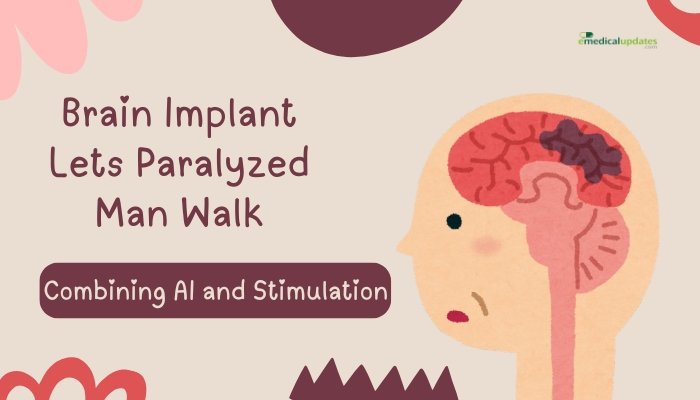Introduction
Spinal cord injuries that result in paralysis often leave few treatment options beyond rehabilitation, assistive devices, or experimental therapies. But a recent breakthrough integrates brain implants, AI-driven decoding, and spinal cord stimulation, enabling a paralyzed patient to regain controlled walking.
By tapping into brain signals above the spinal injury, converting them into movement instructions, and relaying those instructions to the muscles, this approach offers renewed hope for individuals otherwise confined to wheelchairs. Below, we explore how this technology works, its trial results, and the outlook for broader adoption.
The Complexity of Spinal Cord Injuries
The Challenge of Signal Interruption
When a high-level spinal cord lesion occurs, the neural signals from the brain can’t reach muscles below the injury, leading to paralysis. Even if the legs, nerves, and lower spinal segments remain healthy, the “communication highway” is severed.
Traditional Approaches
- Physical Rehab: Strengthens residual functions or fosters compensatory techniques, but can’t restore lost connections.
- Exoskeletons: Provide mechanical support but rely heavily on upper-body input or don’t replicate normal gait fully.
- Implanted Stimulators: Some devices stimulate lower spinal segments to evoke stepping patterns, but lack real-time control from the patient’s intentions.
How the Brain-Spine Interface Works
Brain Implant and AI Decoding
- Implant Location: Electrodes are placed on or within the motor cortex—areas responsible for movement.
- Data Collection: When the patient thinks about walking or moving, the implant records cortical electrical patterns.
- AI Algorithms: Machine learning deciphers these patterns, converting them into digital commands that represent intended leg movements.
Spinal Cord Stimulation
Below the injury site, a stimulator array is implanted on the spinal cord’s surface:
- Signal Transmission: The AI-processed commands wirelessly transfer to the spinal implant.
- Electrical Pulses: Precisely timed pulses activate the corresponding muscle groups in the legs, facilitating gait.
- Adaptive Control: The system can adjust stimulation patterns in real time, matching the user’s intended pace or stride.
Landmark Clinical Case
The Paralyzed Patient
In a widely publicized example, a man with a complete spinal cord injury at the cervical or thoracic level participated in an experimental trial. Before the interface, he had no voluntary leg movement. After months of calibration and training:
- Remarkable Recovery: The participant could stand, walk with assistance, and even ascend steps or navigate uneven terrain to some extent—actions previously impossible.
- User-Driven Control: Because the system relies on brain signals, movement patterns reflect the user’s actual intentions, enhancing naturalness and stability.
Key Milestones
Within weeks or months, the participant progressed from partial weight-bearing steps on a treadmill to more independent walking in real-world settings. Continuous improvement underscores the synergy of advanced neurosurgery, AI-based decoding, and rehabilitative therapy.
Potential Benefits Beyond Walking
Overall Mobility Gains
Users might eventually expand beyond walking: performing controlled standing, transitional movements (e.g., sitting to standing), and extended daily tasks. With practice, the interface could refine fine-grained commands for more nuanced motor function.
Neural Plasticity
Some researchers suggest that re-establishing the “intention-to-movement” loop might encourage residual neural pathways to adapt, further enhancing movement or sensation recovery, even if the original connections remain severed.
Psychological Uplift
Gaining partial autonomy in walking can boost mental health, self-image, and social inclusion for those with spinal cord injuries. The psychological dividends alone warrant continued exploration of such technologies.
Challenges and Next Steps
Complexity and Cost
Building a reliable interface for each patient requires neurosurgery, specialized electronics, custom AI training, and extensive rehab support. Widespread use demands cost reduction and streamlined procedures.
Reliability and Safety
- Durability: Implants must last years without major maintenance or risk of infection.
- Signal Drift: The brain’s neural patterns may shift over time, requiring periodic re-calibration of the AI.
- Battery Life: Wireless energy or recharging methods must be refined to ensure daily use.
Access and Ethical Considerations
Where and how to deploy such advanced technology remain open questions. Factors like insurance coverage, availability of specialized care, and criteria for candidacy might limit initial deployment. Ongoing dialogues about fairness and potential expansions to other disabilities will shape the path forward.
The Future of Neurorestorative Implants
Expanded Trials and Data
Larger multicenter studies are crucial for confirming the reproducibility of these breakthroughs across varied injuries, ages, and rehabilitative environments. Definitive measures of independence, function, and quality of life improvements will guide regulatory approvals.
Combining Therapies
This approach might integrate with exoskeletons, regenerative medicine (e.g., stem cells), or advanced physiotherapy to maximize synergy. Additionally, employing neural plasticity tools—like transcranial magnetic stimulation—could amplify functional gains.
Potential Applications in Other Neurological Conditions
Success in spinal cord injury might inspire similar brain-spine bridging for stroke rehab, multiple sclerosis mobility issues, or degenerative pathologies—broadening the promise of combining AI and electrical stimulation to rebuild lost neural functions.
Frequently Asked Questions
- How quickly can patients walk after implantation?
- Recovery varies; users must train with the system. Some show partial steps within weeks, continuing improvement over months.
- Is the implant permanent?
- For now, yes. The system is designed for long-term use. However, future updates or hardware replacements might be simpler if modules are upgradeable.
- Will it restore sensation, too?
- Currently, the focus is on motor function. Some separate research explores sensory bridging, but that’s not widely integrated yet.
- Does the user still need a walker or cane?
- Possibly. While some achieve independent steps, many also rely on partial support or braces, especially in early phases.
- When will this be broadly available?
- Full rollout may take several years. Ongoing clinical trials must refine safety, efficacy, and cost-efficiency first.
Conclusion
A combined approach of brain implant + AI decoding + spinal cord stimulation marks a pivotal shift in how spinal cord injuries are managed. By bridging the lost neural link between the brain and lower limbs, it grants paralyzed individuals the ability to stand and walk—once an unthinkable goal. Although the technology remains in trial phases and challenges like cost, complexity, and maintenance persist, the evidence so far is inspiring.
If scaled successfully, paralyzed patients worldwide could eventually access a chance to regain meaningful mobility, drastically enhancing independence and quality of life. This synergy between advanced neuroscience, cutting-edge AI, and rehabilitative therapy underlines a new era of hope for paralyzed individuals—once again reaffirming how science can push the boundaries of what’s medically possible.
References
-
Van den Brand R, et al. (2016). “Restoring voluntary control of locomotion after paralysis.” Nature.
-
Wagner FB, et al. (2018). “Targeted neurotechnological intervention for spinal cord injury.” Nature.
-
Courtine G, et al. (2020). “Brain-spine interfaces: bridging spinal cord lesions for motor recovery.” J Neurosci Methods.
-
Minev IR, et al. (2022). “Electrical e-bridges for motor function restoration.” Sci Transl Med.





